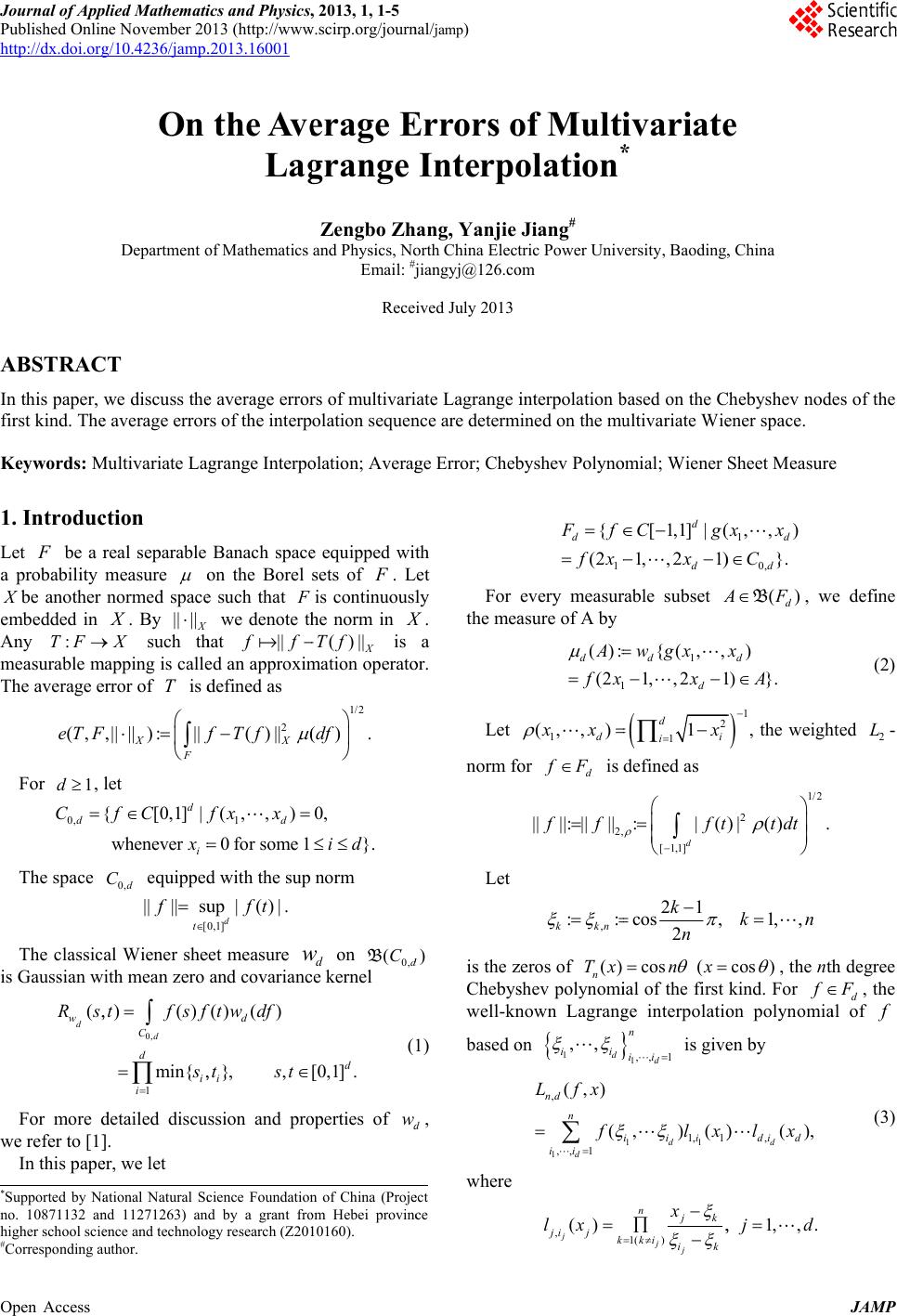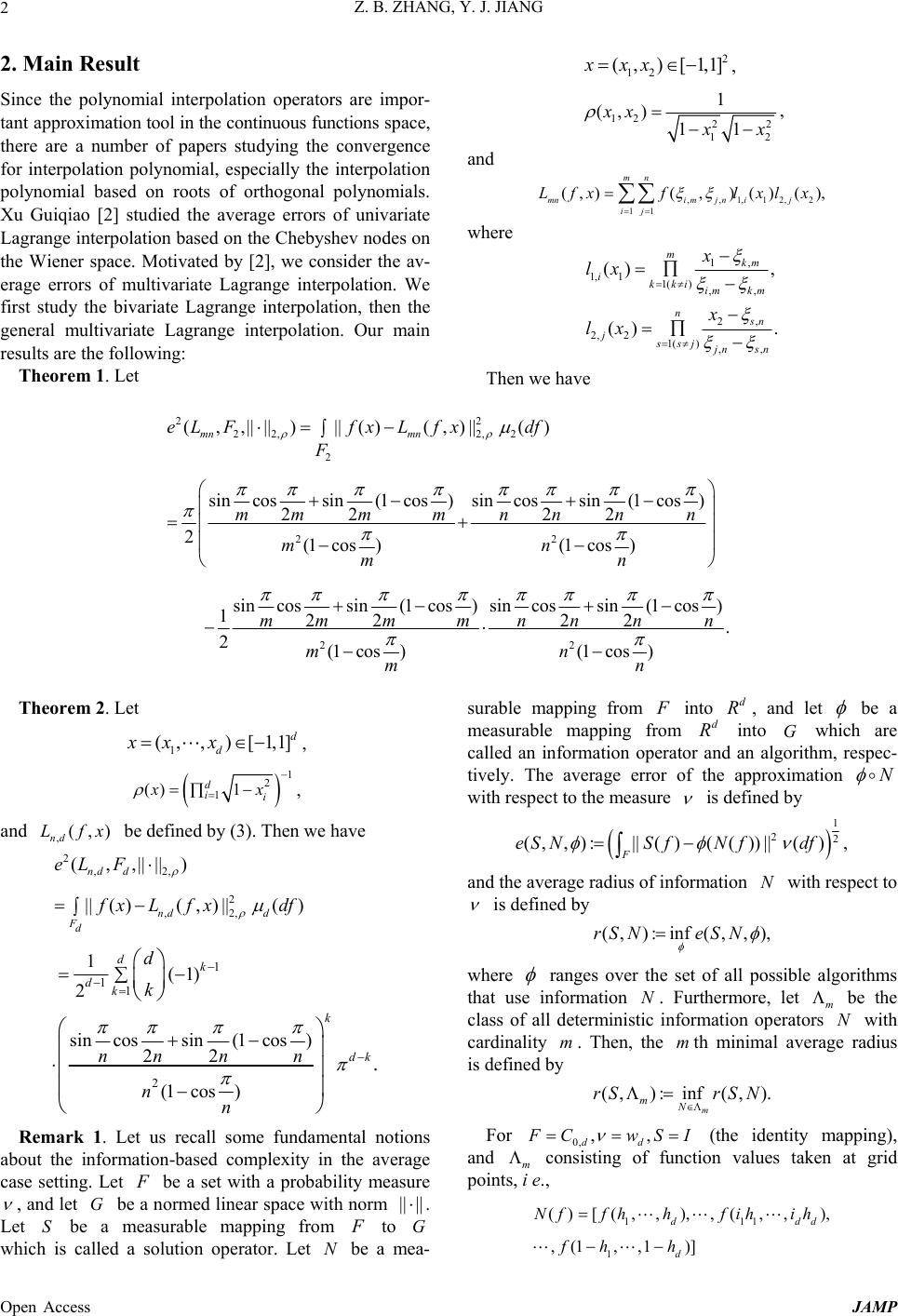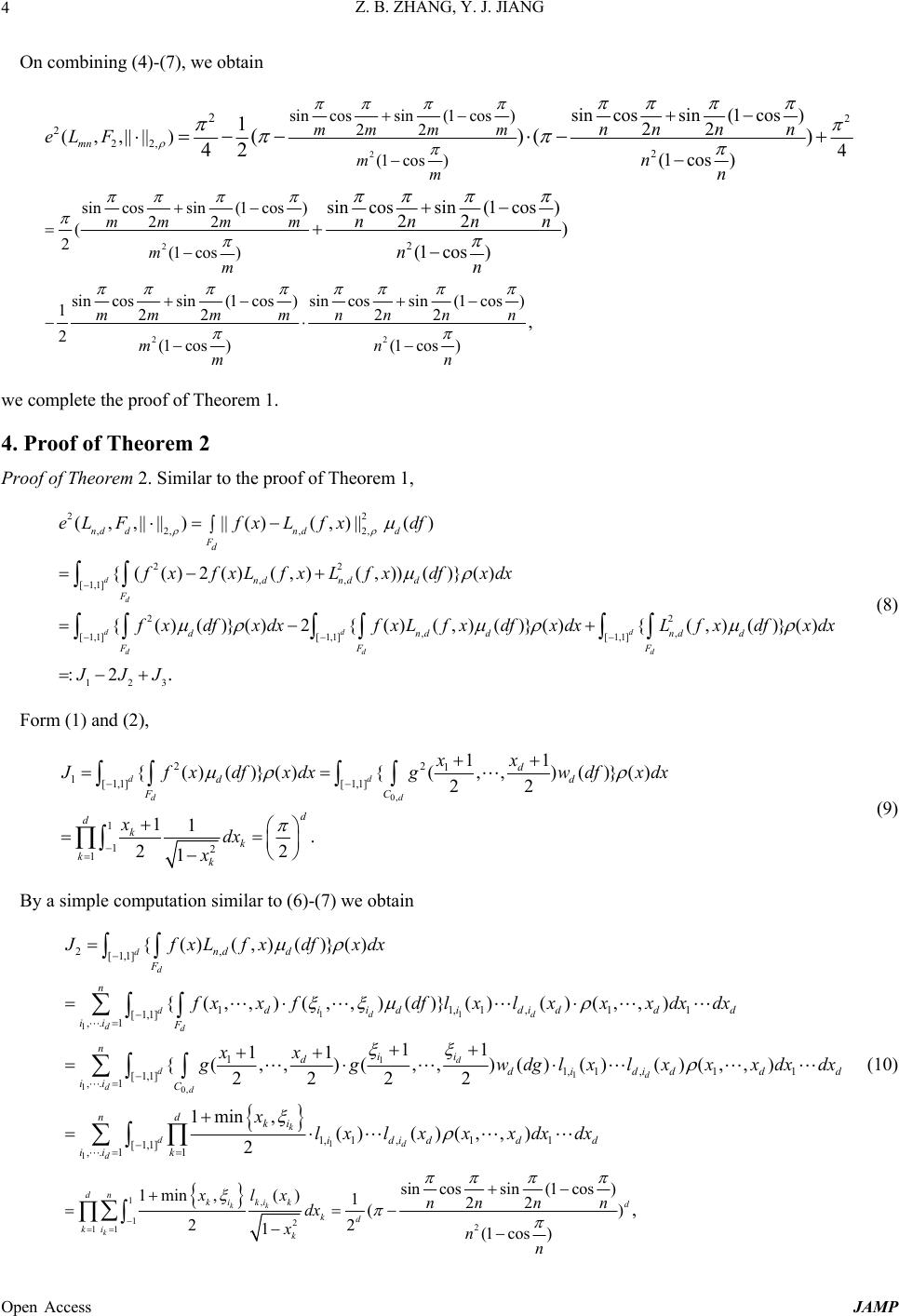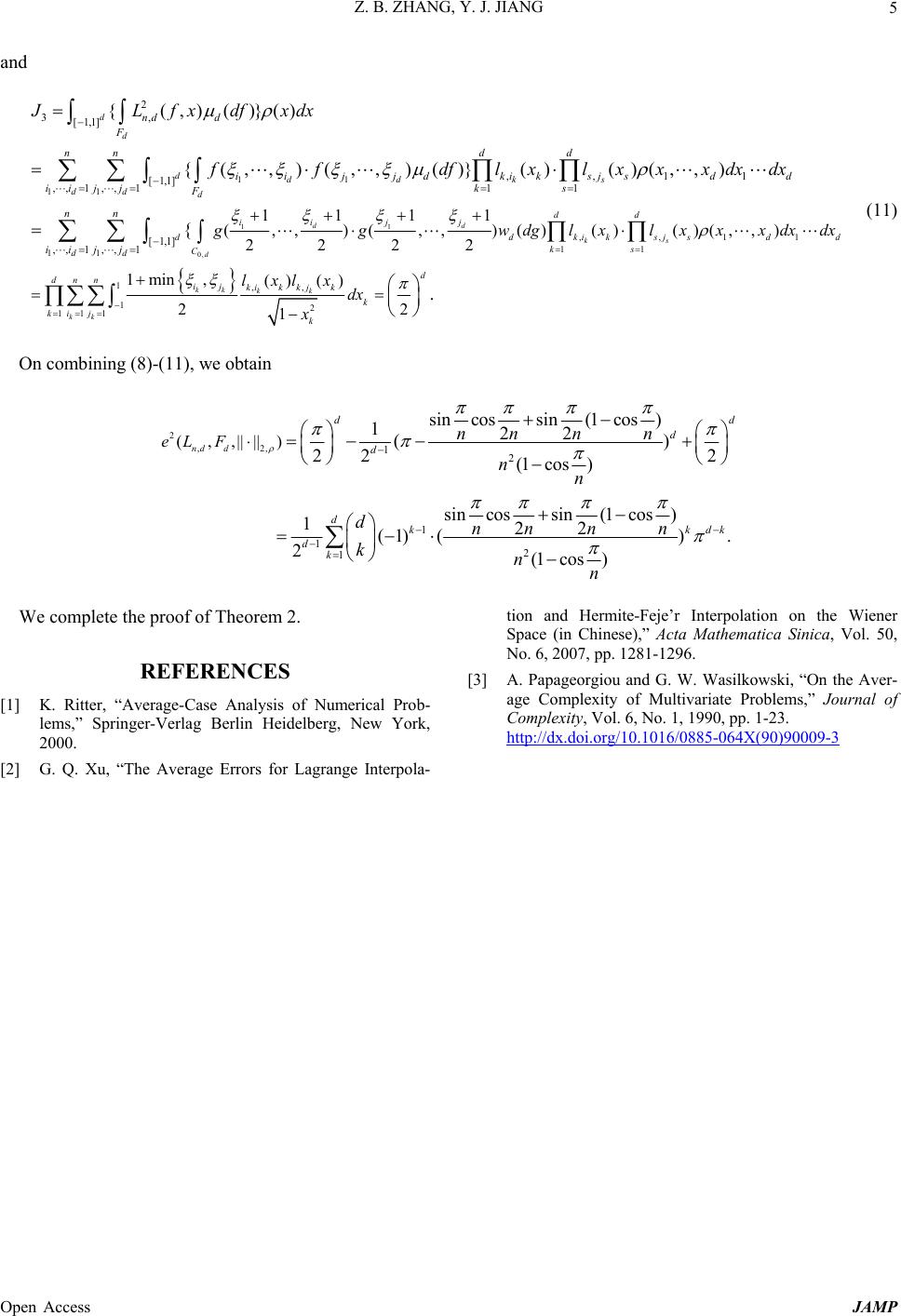Paper Menu >>
Journal Menu >>
 J ournal o f A pp Published Onli n http://dx.doi.or g Open Access ABSTRA C In this p aper, first kind. Th e Keywords: M 1. Introdu c Let F b e a r a probability X b e another embedded in Any :TF measurable m The average e (,eT F For 1d , 0,d C The space The classic is Gaussian w ( , d w Rs For more d we refer to [1 ] In this pap e * Supported by N a no. 10871132 a n higher school sci e # Corresponding a p lied Mathemat i n e November 2 0 g /10.4236/jamp . On Department o C T we discuss th e e average erro r M ultivariate L a c tion r eal separable measure o normed spac e X . By || || X X such t h m apping is call e e rror of T is d ,||||):|| XF Ff le t {[0,1]| whenever d i fC f x 0,d C equippe d [ || || s u t f al Wiener sh e w ith mean zero 0, 1 , )() min{ , d C d i i tfs f s d etailed disc u ] . e r, we le t a tional Natural S c n d 11271263) a n e nce and technol o a utho r . i cs and Ph y sics , 0 13 (http://ww w .2013.16001 the Av e La g o f Mathematics e average erro r r s of the inter p a grange Int erp o Banach spac e o n the Borel e such that F we denote t h h at || f f e d an approxi m d efined as 2 ()|| ( X f Tf 1 (, ,) 0for some 1 d f xx d with the sup 0,1] u p| ()| d ft . e et measure w and covarian c ()( ) , }, , d i f tw df tst u ssion and pr o c ience Foundatio n n d by a grant fr o o gy research (Z20 1 , 2013, 1, 1-5 w .scirp.org/jour n e rage E g range Zengbo Z h and Physics, N o Email: # j Rece r s of multivar i olation seque n o lation; Avera g e equippe d wi t sets of F . L is continuous l h e norm in X ()|| X Tf is m ation operat o 1/2 ( ).df 0, }.id nor m d w on 0, ( d C B c e kernel [0,1] . d ( o perties of d w n of China (Proj e o m Hebei provin c 1 0160). n al / jamp ) E rrors o Interp o h ang, Yanjie o rth China Elec t j iangyj@126.c o ive d July 2013 i ate Lagrange i n ce are deter m g e Error; Che b t h L e t ly X . a o r. ) d 1) d , For the me a Let norm f o Let is the z Cheby s well-k n b ased o where e c t c e o f Mult i o lation * Jiang # t ric Power Uni v om i nterpolation b m ined on the m u b yshev Polyn o 1 { (2 d F f f x every measu r a sure of A by 1 (): (2 d A f x 1 (, , ) d x x or d f F is 2, || ||:|||| f f , :: kkn z eros of () n Tx s hev polynom i n own Lagran g o n 1 ,, d ii 1 , ,, 1 (,) ( d nd n ii Lfx f , () j ji jk lx i variat e * v ersity, Baoding , b ased on the C u ltivariate Wi e o mial; Wiener [1,1]| ( 1,, 21 ) d d Cg x r able subse t A 1 1 {( ,, 1,,2 1 d d wgx x 2 1 1 d i i x defined as [1,1] :|( ) d ft 21 cos , 2 k n cos (nx i al of the first g e interpolati o 1 ,, 1 d n ii is giv e 11 1, 1 ,)( ) d iii lx 1( ) , jj n j k ki ik x e , China C hebyshev no d e ner space. Sheet Measur e 1 0, ( ,,) ) }. d d xx C () d A F B , w ) 1 )}. d x A 1 , the weig h 1/2 2 ) |() .tdt 1, , kn cos ) , the n t h kind. For f o n polynomi a e n b y , ) (), d di d lx , 1,, .jd JAMP d es of the e w e define (2) h ted 2 L - t h degree d F , the a l of f (3)  Z. B. ZHANG, Y. J. JIANG Open Access JAMP 2 2. Main Result Since the polynomial interpolation operators are impor- tan t app rox imation tool in the continuous functions spa ce, there are a number of papers studying the convergence for interpolation polynomial, especially the interpolation polynomial based on roots of orthogonal polynomials. Xu Guiqiao [2] studied the average errors of univariate Lagrange interpolation based on the Chebyshev nodes on the Wiener space. Motivated by [2], we consider the av- erage errors of multivariate Lagrange interpolation. We first study the bivariate Lagrange interpolation, then the general multivariate Lagrange interpolation. Our main results are the following: Theorem 1. Let 2 12 (, )[1,1]xxx , 12 22 12 1 (, )11 xx x x , and ,,1,12,2 11 (,)(,)()(), mn mni mj nij ij Lfx flxlx where 1, 1, 11() ,, 2, 2, 21( ) ,, () , () . mkm ikkiim km nsn jssj j nsn x lx x lx Then we have 22 22,2,2 2 22 2 (,,||||) ||()(,)||() sincossin(1 cos)sincossin(1 cos) 22 22 2(1 cos)(1 cos) sincossin(1cos) sincossin 122 22 2(1 cos) mn mn eL FfxLfxdf F mm mm nnnn mn mn mmmm nnn mm 2 (1cos) . (1 cos) n nn Theorem 2. Let 1 (, , )[1,1] d d xx x, 1 2 1 () 1 d ii xx , and ,(,) nd L fx be defined by (3). Then we have 2,2, 2 ,2, (,,||||) ||( )(,)||() nd d nd d Fd eL F f xL fxdf 1 11 2 1(1) 2 sincossin(1 cos) 22 (1 cos) . dk dk k dk d k nn nn nn Remark 1. Let us recall some fundamental notions about the information-based complexity in the average case setting. Let F be a set with a probability measure , and let G be a normed linear space with norm || || . Let S be a measurable mapping from F to G which is called a solution operator. Let N be a mea- surable mapping from F into d R, and let be a measurable mapping from d R into G which are called an information operator and an algorithm, respec- tively. The average error of the approximation N with respect to the measure is defined by 1 22 (,,):|| ()(())||(), F eSNS fNfdf and the average radius of information N with respect to is defined b y (, ):inf(, ,),rSNeSN where ranges over the set of all possible algorithms that use information N. Furthermore, let m be the class of all deterministic information operators N with cardinality m. Then, the mth minimal average radius is defined by (,):inf(, ). m mN rS rSN For 0,,, dd F CwSI (the identity mapping), and m consisting of function values taken at grid points, i e., 111 1 ()[(,, ), ,(, ,), ,(1,,1)] ddd d Nffhhfih ih fh h  Z. B. ZHANG, Y. J. JIANG Open Access JAMP 3 for some 1,, d hh, by [3,p.16] we know 12 1 (, ). md rS m From Theorem 2 we have ,2, 12 1 (,,||||) . nd d eL Fn Note that d mn , we can say that the average error of ,nd L is weakly equivalent to the corresponding d n th minimal average radius. 3. Proof of Theorem 1 Proof of Theorem 1. By a simple computation, we have 2 2 2 2 22 22 2 22, 2 [1,1] 22 2 [1,1] 2 2 222 [1,1] [1,1] 2 (,,||||)|()(,)|() () {()2()(,)(,)()}() {() ( )}()2{()(,) ( )}(){(,)( mn mn F mn mn F mn mn FF eL FfxLfxxdxdf fxfxL fxLfxdfxdx fx dfxdxfxLfx dfxdxLfx df 2 2 [1,1] 123 )}( ) :2 . F x dx III (4) On using (1) and (2), we obtain 22 20,2 22 12 12 2 [1,1] [1,1] 2 11 12 12 11 22 12 11 {()()}(){ ( ,)()}() 22 1111 . 224 11 FC xx I fx dfxdxgwdgxdx xx dx dx xx (5) From [2], we have 2 2 2 0,2 11 22 12,,21,12,21212 [1,1]1 1 11 11 12 11 11 , ,21,12,2 {()(,)()}() (,)(,)()()()(,) 11 (,) 22 1 1 (,)()()() 22 mn mn im jnij ij FF mn ij C jn im ij IfxLfxdfxdxfxxfdflxlxxxdxdx xx ggwdglxlx 12 12 11 2, 1, 1,1 2,21212 11 11 12, 1, 2, 2 1, 112 122 11 12 2 (,) 1min , 1min ,()()(,) 22 1min , 1min ,() () 22 11 sincossin(1 cos) 122 ( 4(1 mn jn im ij ij mn jn im j i ij xxdxdx x xlxlxxxdx dx x xlx lxdx dx xx mm mm m 2 sincossin(1 cos) 22 )( ), cos)(1 cos) nn nn n mn (6) and 0,2 2 32 2 [1,1] 2 ,,,,21,11,12,22,2 1212 1111 2 1111 11 11 11 , , 11 {(,)()}() (,)(,)()()()()()(,) 1 1 (,) 22 mn mnmn imjnkm snikjs ijks mmn ijks F F njm im C ILfxdfxdx ffdflxlxlxlxxxdx dx g ,, 21,1,2,2, 1212 11 ,, ,, 2,2 2,2 1,1 1,11 2 22 11 11 11 12 2. 11 (,)() ()()()()(,) 22 1min , 1min ,()() () () 22 11 4 km snikj s mmn njnsn im kmjs ik ik js g wdglxlxlylyx xdxdx lxlx lxlx dx dx xx (7)  Z. B. ZHANG, Y. J. JIANG Open Access JAMP 4 On combining (4)-(7), we obtain 2 2 2 222, 2 2 2sincossin(1 cos) 22 (1 cos) sincossin(1 cos) 22 ( 2(1 cos) 1 2 sincossin(1 cos) 22 (,,||||) 4 (1 cos) sincossin(1 cos) 22 ) (1 cos) 1()( ) 42 mn mm mm mm mm mm mm nn nn eL Fnn nn nn nn 22 sincossin(1cos) sincossin(1cos) 22 22 (1 cos)(1 cos) , mmmm nnnn mn mn we complete the proof of Theorem 1. 4. Proof of Theorem 2 Proof of Theorem 2. Similar to the proof of The orem 1, 22 ,2, ,2, 22 ,, [1,1] 2 2 ,, [1,1] [1,1] (,,||||) ||()(,)||() {(()2()(,)(,))( )}() {( )()} ( )2{( )(,)()} (){(,)() d d dd dd nd dndd Fd ndnd d F dnddndd FF eL Ffx Lfxdf fxfxLfx Lfxdfxdx fx dfxdxfxLfxdfxdxLfx df [1,1] 123 }() :2 . d d F x dx JJJ (8) Form (1) and (2), 0, 22 1 1[1,1] [1,1] 1 12 1 1 1 {()()} ( ){(,,)()} () 22 11. 22 1 dd dd d dd FC d dkk kk x x J fxdfx dxgwdfx dx xdx x (9) By a simple computation similar to (6)-(7) we obtain 11 1 1 10, 2, [1,1] 11,1,11 [1,1] ,. 1 1 [1,1] ,. 1 {()(,)()}() {(,,)(,,)()}() ()(,,) 1 1 1 1 { (,,)(,,)() 2222 d d ddd dd d d dd nd d F n diid ididdd ii F ni i dd ii C JfxLfxdfxdx fx xfdflxlxx xdxdx x x ggwdg 1 1 1 1, 122 1 1 1, 1,11 1, 1,11 [1,1] ,. 11 sincossin(1 cos) 1min,() 122 ( 22 1(1 cos) ()( )(,,) 1min ,()( )(,,) 2 kk k d k dd d dnki ki k kd i kk ididd d d nki ididdd ii k xlx nnnn dx xnn lxlxxxdxdx xlxlxxx dxdx ), d (10)  Z. B. ZHANG, Y. J. JIANG Open Access JAMP 5 and 1 0, 11 11 11 2 3, [1,1] ,,11 [1,1] ,, 1,,111 [1,1] ,,,, 1 1 1 (,,) 22 {(,)()}() {(,,)(,, )()}()()(,,) {d d d d ddd ks dd d i i d C d ndd F dd nn iij jdkiksjsdd ii j jks F n ijj g JLfxdfxdx ffdflxlxxx dxdx 1,,11 11 1,, 12 11 1 1 1 1 ( ,,)() ()()(,,) 22 1min,()() 22 1. d ks kk kk kk dd j j dkiksjsd d ks d d dnn ijkikkjk k ij kk n i g wdglxlxxxdx dx lxlx dx x (11) On combining (8)-(11), we obtain 2 ,2,12 1 12 1 (,,||||)sincossin(1 cos) 122 () 22 2(1 cos) sincossin(1 cos) 122 (1) (). 2(1cos) nd d d d d d dkkdk dk eL Fnn nn nn dnn nn knn We complete the proof of Theorem 2. REFERENCES [1] K. Ritter, “Average-Case Analysis of Numerical Prob- lems,” Springer-Verlag Berlin Heidelberg, New York, 2000. [2] G. Q. Xu, “The Average Errors for Lagrange Interpola- tion and Hermite-Feje’r Interpolation on the Wiener Space (in Chinese),” Acta Mathematica Sinica, Vol. 50, No. 6, 2007, pp. 1281-1296. [3] A. Papageorgiou and G. W. Wasilkowski, “On the Aver- age Complexity of Multivariate Problems,” Journal of Complexity, Vol. 6, No. 1, 1990, pp. 1-23. http://dx.doi.org/10.1016/0885-064X(90)90009-3 |

